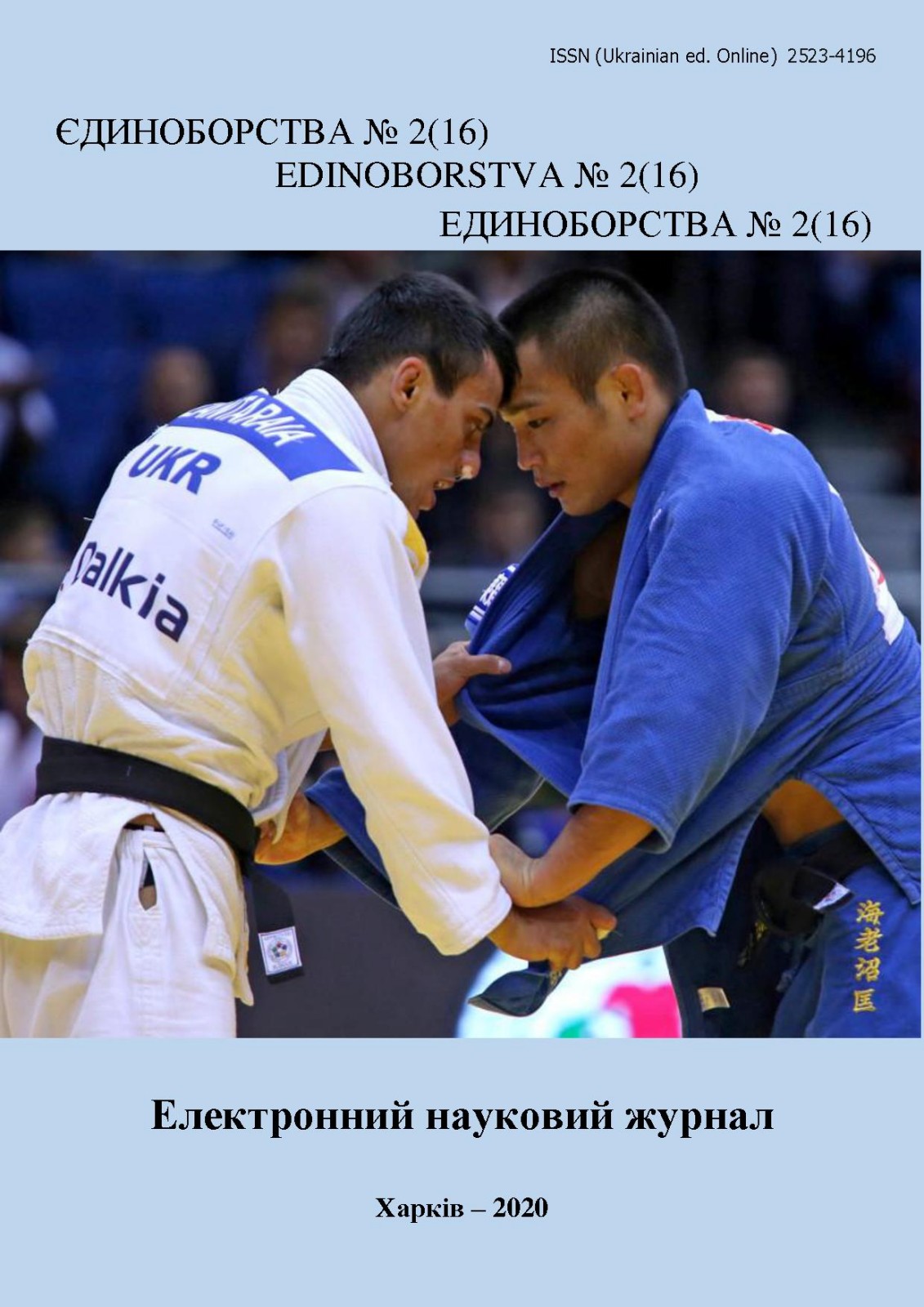Dynamics of endurance indexes of Taekwondoists 12-14 years under the influence of the proposed means
DOI:
https://doi.org/10.15391/ed.2020-2.05Keywords:
endurance, load, development, taekwondo, techniqueAbstract
Purpose: to investigate the dynamics of endurance indexes of Taekwondoists 12-14 years under the influence of the proposed means. Materials and methods. The study involved 30 athletes specializing in taekwondo, the age of 12‑14 years in Izyum Children and Youth Sports School named V. Tkachenko, Kharkiv region. The study used the following research methods: theoretical analysis and generalization of scientific and methodological literature and the Internet, pedagogical observation, pedagogical testing, methods of mathematical statistics. Results: After using our proposed methods, under the influence of training load, the endurance indicators of athletes improved as follows: in the test, which measured the number of changes of racks in 1 minute, the coefficient of variation in the experimental group is 8 %, and in the control group – 11 %, the difference between the average is 0,03. When measuring the number of strokes in 5 spurs in 3 minutes, the coefficient of variation in the experimental group is equal to 24 % and in the control group 40 %, the difference between the mean values is 0,93 strokes, the result in the experimental group improved by almost 1 stroke in each spurt, and the coefficient of variation indicates that the control group had too large a run of indicators, and in the experimental group the indicators are closer. When testing the «eight» run, the coefficient of variation in the experimental group is 15 %, and in the control – 16 %, the difference between the average was 0,99 seconds. Almost every athlete significantly improved their result in the experimental group, the control group also improved the result, but not so much. In the 1500 m run, the coefficient of variation in the experimental and control groups was the same as 15 %, and the difference between the arithmetic mean was 0,36 minutes. Conclusions. Taekwondo athletes need training to improve their aerobic abilities, which results in the development of oxygen supply systems in order to maximize the efficiency of a match consisting of 3 rounds of 2 minutes, with only 1 minute break for partial restoration of energy resources. However, work under significant hypoxia, under anaerobic conditions, also plays a minor role in the fights. The use of our endurance improvement technique offers us the opportunity to significantly improve the quality of preparation of taekwondo players for competitions and thereby to make a significant contribution to the training process, which will inevitably lead to victories in the future. On the basis of the conducted researches it was found that on the average in the group of the taekwondo sportsman of the experimental group the indicators of physical fitness improved: in the test the change of stability in 1 minute the result improved by 3 %, the number of beats in 5 spurs in 3 minutes ‑ by 18 %, the run by «eight» 1 %; Running 1500 m 2 %, which indicates the effectiveness of our proposed method of endurance development. As a result of the experiment, it was found that the performance of all tests became better in both the experimental and the control group. However, after the experiment, there was an increase in endurance development in both groups, but the indicators in the control group improved slightly, but in the experimental group more significant changes were observed.
References
Матвеев, Л. П. (2006). Теория и методика физической культуры. 4-е издание, Омега– Л, Москва.
Палій, О. В., & Пашков, І. М. (2018). Динаміка розвитку витривалості тхеквондистів 12 14 років. Єдинобрства №3(9), 32–40.
Палій, О. В., & Пашков, І. М. (2019). Особливості функціональних здібностей тхеквондистів. Єдиноборства, № 2(12), 39-47.
Пашков, І. М., & Палій, О. В. (2017). Особливості розвитку витривалості у тхеквондо. Єдиноборства, № 2(13), 43 46.
Пашков, І. М. (2015a). Адаптаційні процеси тхеквондистів під впливом великих фізичних навантажень. Науковий часопис Національного педагогічного університету імені М.П. Драгоманова. Серія №15. «Науково-педагогічні проблеми фізичної культури /Фізична культура і спорт/» 36. наукових праць, Випуск 3(58)15, 93–95.
Пашков, И. Н. (2015b). Повышение уровня физической работоспособности в тхеквондо на этапе предварительной базовой підготовки. Науковий часопис Національного педагогічного університету імені М.П. Драгоманова. Серія №15. «Науково- педагогічні проблеми фізичної культури /Фізична культура і спорт/» 36. Наукових праць, Випуск 4 (59), 60–63.
Платонов, В. Н. (2015). Система подготовки спортсменов в олимпийском спорте. Общая теория и ее практические приложения : учебник [для тренеров] : 2 кн. Олимп. лит., Киев.
Помещикова, І. П., Рубан, Л. А. & Науменко, Л. Г. (2015). Функціональний стан серцево-судинної системи у баскетболісток команди першої ліги у процесі проведення лікарсько-педагогічних спостережень. Слобожанський науково-спортивний вiсник. – Харків : ХДАФК. №1(45), 100–103
Ровная, О. А. (2015). Спортивная физиология. Учебное пособие. ХГАФК, Харьков.
Ровний, А. С., Ільїн, В. М., Лизогуб, В. С., & Ровна, О. О. (2015). Фізіологія спортивної діяльності. ХНАДУ, Харків.
Ровний, А. С., & Язловецький, В. С. (2005). Фізіологія спорту. Навчальний посібник. Друге видання. Кіровоград: РВВ КДПУ імені Володимира Винниченка.
Ровный А. С., Романенко, В. В., & Пашков, И. Н. (2013). Управление подготовкой тхеквондистов. [Монография]. Харьков.
Солодков, О. С., & Сологуб, О. Б. (2005). Физиология человека. Общая. Спортивная. Возрастная. Учебник. 2–е изд., испр. и доп. : Олимпия Пресс, Москва.
Уилмор, Дж. Х. (2001). Физиология спорта: Пер. с англ..: Олимпийская литература. Київ.
Чинкин, А., & Назаренко, А. (2017). Физиология спорта. Учебное пособие. Litres.













